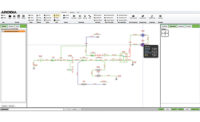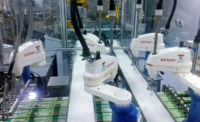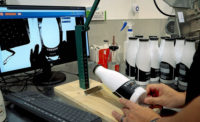Many questions surround artificial intelligence (AI). A common one among non-users is: Can something artificial truly produce real-world benefits? Increasingly, manufacturers in the automotive industry are ready and able to provide an affirmative answer.
One such company is Volvo Cars, which has recently begun using the AI-based Atlas inspection system from UVeye. Since February 2020, Volvo has partnered with UVeye and implemented Atlas at its manufacturing plant in Torslanda, Sweden. There, several system cameras quickly perform a 360-degree scan of each just-assembled vehicle at the end of the assembly line to detect cosmetic defects like scratches and dents.
“The system has proven to be more efficient and accurate than the manual-inspection process,” notes David Oren, chief strategy officer at UVeye. “Any and all exterior imperfections are immediately picked up by the system and shown on a large screen to the attending technician.”
At the January 2020 Consumer Electronics Show, another automotive OEM, Honda, announced a partnership with UVeye as part of Honda’s Xcelerator program to invest in innovative technologies.
“From a digital information perspective, vision technology has always been based on AI,” says Oren. “This is because AI gives meaning to the pixels captured by the vision system, and has since the 1990s, regardless of the algorithms used by the vision system.”
Other auto manufacturers are using Atlas in a limited way as well, including Toyota, Skoda and Daimler. However, Oren says the system has the potential to dramatically change how carmakers, their suppliers, dealers and major fleet operators inspect vehicles in the near future.
Detecting tiny exterior imperfections is just the first step. Next, Oren opines, OEMs worldwide will use the system to automatically check vehicle chassis, suspension systems, sheet metal and tires for missing parts, postproduction damage and other quality-related issues.
Without question, UVeye’s AI engine is a key technology that accounts for the Atlas system’s numerous capabilities. But, there are others, including the company’s proprietary algorithms, cloud architecture, sensor fusion and machine learning.
From Detecting Bombs to Finding Scratches
How the Atlas system came to be is an interesting story that stretches back some 6.5 years. In the summer of 2014, Amir Hever witnessed the manual inspection of vehicles in Israel for security threats. The traditional approach there is for a security guard to circle beneath a vehicle with a mirror on the end of a long pole to try and spot weapons or explosives.
Considering this test to be outdated, unreliable, and, most importantly, life threatening, Hever decided to found UVeye with his brother Ohad. Their company name is short for under vehicle eye.
By the fall of 2016, UVeye had developed fixed and mobile versions of an inspection system called Helios that automatically detects visual anomalies on the undercarriage of any vehicle. The fixed-unit version is most suitable for facilities with permanent entrances, while the mobile version is designed especially for law enforcement agencies, security firms and intelligence organizations that must easily scan passing vehicles.
In 2017, UVeye exhibited at the Smart Mobility and EcoMotion trade shows in Israel and drew great interest in Helios from automotive manufacturers. UVeye started working with these companies to determine the viability of its product. The OEMs said they wanted a system that can detect anomalies on the exterior surfaces of the vehicle, as well as the undercarriage.
“We were able to take Helios technology from the software point of view and build hardware for the vehicle exterior to detect anomalies,” notes Oren. “These could include dents, scratches, hail damage and alignment problems.”
Further work led to the development of the Atlas inspection system in August 2017. Pilot programs by two German OEMs occurred during 2018 and 2019, as well as UVeye performing a live demo of the system at a tradeshow in April 2018. Interest in Atlas then grew among Japanese, European and North American carmakers.
“Both German manufacturers discovered that Atlas found 10 to 40 percent more anomalies than workers did during manual inspection,” says Oren. “These issues were paint chips and micro scratches measuring 0.2 to 0.3 millimeter in size.”
Good Tunnel Vision
Vehicle inspection with the Atlas system happens quite quickly. Typical cycle time is 5 to 20 seconds, depending on car dimensions, according to Oren.
The main component of the system is an aluminum tunnel that the vehicle moves through, usually on an end-of-line conveyor. This tunnel measures 2 meters long, 3.5 to 4 meters high and 4.5 meters wide.
“Built into this tunnel frame are multiple sensors, several lights and more than 20 industrial-vision cameras,” explains Oren. “As the vehicle enters the tunnel, its lights are on and the sensors trigger the opening of a nearby database that identifies the car by VIN number, including its make, model, year and key features like color and dimensions.”
Next, the cameras take many pictures of the car from angles covering all 360 degrees of the vehicle. Oren says each camera takes hundreds of high-resolution images per second, for an average total of a few thousand per vehicle.
“What’s most impressive is the system compiles about 10 gigabytes of image data for every car,” says Oren. “To put that in perspective, a typical 2-hour, high-definition movie contains about 4 gigabytes of data.”
Once the car passes through the tunnel, the data-processing phase begins. All image data is simultaneously sent to an onsite and an offsite (cloud) server for analysis. The latter may be public or private, such as that operated by the OEM.
“The analytics phase happens super quickly, and includes the creation of a 3D model of the vehicle that indicates where all anomalies are present,” says Oren. “This model helps correlate all different parts of the car.”
Within seconds, the results are presented on a large screen to the workstation operator or operators. They learn whether or not there are defects, and if so, where the defects are specifically located. The quality manager at the plant is also able to access this information on demand from his office computer. In addition, all data is stored in the system for future reference and further analysis, such as to determine anomaly trends of certain areas of a vehicle, like the door or side panel.
Oren says the Atlas system uses multi-layered technology, with off-the-shelf sensors, cameras and lighting at the bottom. Above that are a few layers of data processing that separate the huge amount of vision data into chunks. At the top is the AI engine that uses deep learning to analyze the data and provide anomaly detection at different levels of resolution, to an accuracy of 0.1 millimeter.
“Manufacturers really like that Atlas enables data digitalization, thereby eliminating the need for hand-written data, which is more susceptible to errors,” explains Oren. “It also gives OEMs the freedom to adjust the level of detection they want depending on the type of vehicle being inspected; for example, a premium luxury car versus an economy compact.”
Limitations and Opportunities
Despite the advanced AI abilities of Atlas, the system does have a couple noteworthy limitations. One is that it is about 99.99 percent foolproof. “Nothing is 100 percent foolproof,” acknowledges Oren.
The other limitation is that it can only be used on the outside of a car. “OEMs often ask us if the system is able to find imperfections in a vehicle’s interior,” says Oren. “We must be honest and tell them no.”
Atlas does present some challenges to end-users. First , workers must never be present anywhere in the tunnel during vehicle inspection. Doing so can cause optical blockages. “The cameras can only detect anomalies if it sees them,” according to Oren.
OEMs also need to properly integrate the Atlas inspection system into the end of their assembly line. Although doing this does not require physical changes to the plant or increase takt time, it does impact workers who previously performed manual inspection.
“The company has likely done manual inspection for a long time, but now that process has been digitized and workers are being trained in the new approach,” says Oren. “As a result, such workers now have more time to perform other tasks in between car inspections. This transition can be challenging, but, because each company’s situation is a little different, there is no simple formula for the end-user to follow to get through it.”
Thus far, each OEM has implemented the Atlas system one shift at a time. This lets the company work out kinks in the system before using it in the second and third shifts where applicable.
Several users have set up the system so that all anomalies are immediately fixed at the plant. Others prefer to have the vehicles sent to another location for repair work. Also, an OEM may or may not have its workers mark the anomalies. It is all a matter of preference.
UVeye maintains ownership of all system components at all times, according to Oren. An end-user simply pays a flat fee for each vehicle inspected.
“Let’s say that an OEM inspects an average of 60,000 vehicles per year on an assembly line,” says Oren. “If the Atlas system finds just 5 percent more damages than the company’s manual-inspection process, that could result in the manufacturer saving hundreds of thousands of dollars.”
To optimize system uptime, UVeye actively and remotely monitors each Atlas installation. Oren says maintenance includes at least one annual visit by UVeye to the plant. OEMs are free to do their own additional maintenance as well.
Immediately after system installation, UVeye trains the workers that will oversee the system. Each end-user company also gets a detailed training manual and a maintenance guide.
“Maintenance is minimal because there are no moving parts on the Atlas,” explains Oren. “It’s just sensors, lights and cameras mounted on a frame that is connected to a computer. However, if one of the lights starts flickering or a camera stops working, we’ll immediately know about it and so will the end-user.”
UVeye has both short- and long-term goals for the Atlas system. The company’s current focus is growth and R&D in the automotive market, including Tier 1 suppliers that use Atlas to inspect just-received parts and just-built products or subassemblies for defects as they move along a conveyor. Down the road Oren is hopeful that the system will be used in all areas of mobility, such as trains, subways and aviation.
“We regularly work with automotive engineers, and sometimes it’s not immediately clear to them the importance of perceived quality by the general public,” concludes Oren. “The finding of any scratch on a new vehicle changes that customer’s perception of the manufacturer, and does so in a negative way.”







